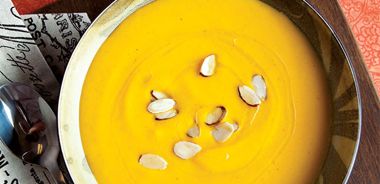Carrot and Parsnip Soup

This soup gives you a burst of energy, as all ingredients keep their nutrients. When I serve this soup to my friends, I watch them make a funny face when I mention parsnips, until they take their first mouthful ... and then they get it! Yum!
1 Tbsp (15 mL) extra-virgin olive oil
1 small onion, chopped
2 cups (500 mL) chopped carrots
1 cup (250 mL) chopped parsnips
1 medium potato, peeled and finely chopped
1/2 tsp (2 mL) pepper
1 tsp (5 mL) grated nutmeg
3 cups (750 mL) low-sodium chicken broth
1 cup (250 mL) 2% milk or almond milk
2 Tbsp (30 mL) toasted sliced almonds, for garnish
Heat oil in pressure cooker over medium-high heat. Add onion and cook for 2 minutes, or until onion begins to soften. Add carrots, parsnips, potato, pepper, nutmeg, and chicken broth. Lock lid in place and cook for 10 minutes. Quick-release pressure and open lid. Taste and adjust seasonings, adding salt if required.
Pour soup into blender and purée until smooth. Return to pressure cooker, add enough milk to achieve desired consistency, and reheat without bringing to a boil. Serve garnished with toasted sliced almonds.
Serves 6.
Each serving contains: 126 calories; 3 g protein;
4 g total fat (1 g sat. fat, 0 g trans fat); 20 g total carbohydrates (6 g sugars, 3 g fibre); 221 mg sodium
source: "Pressure Cooking", alive #372, October 2013




